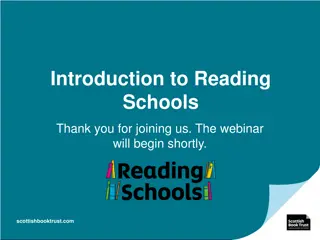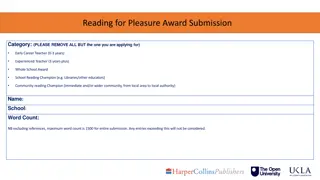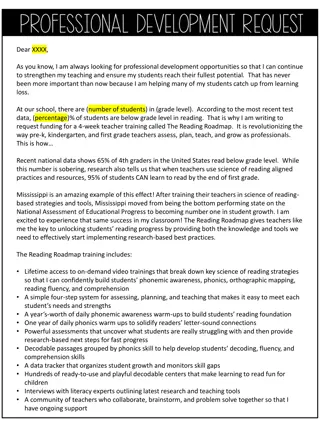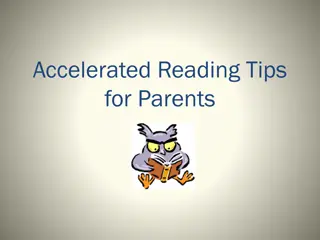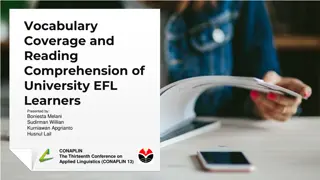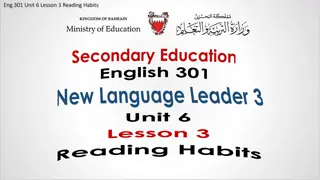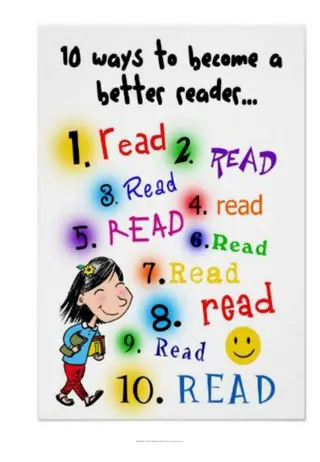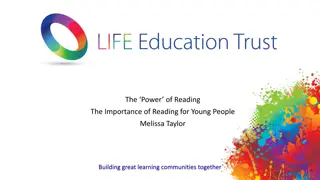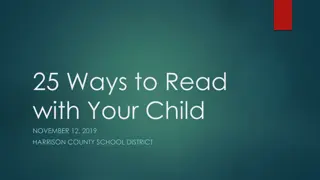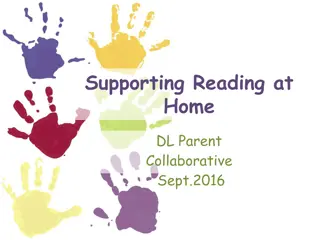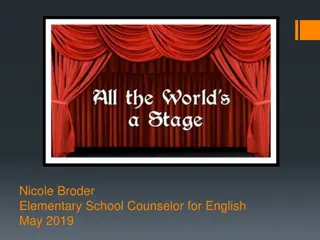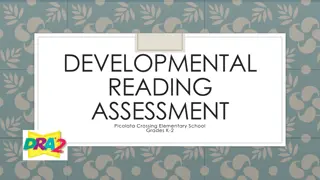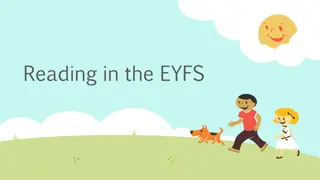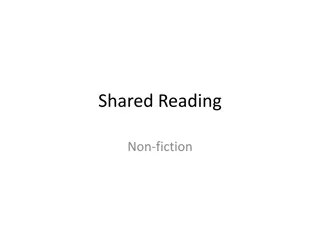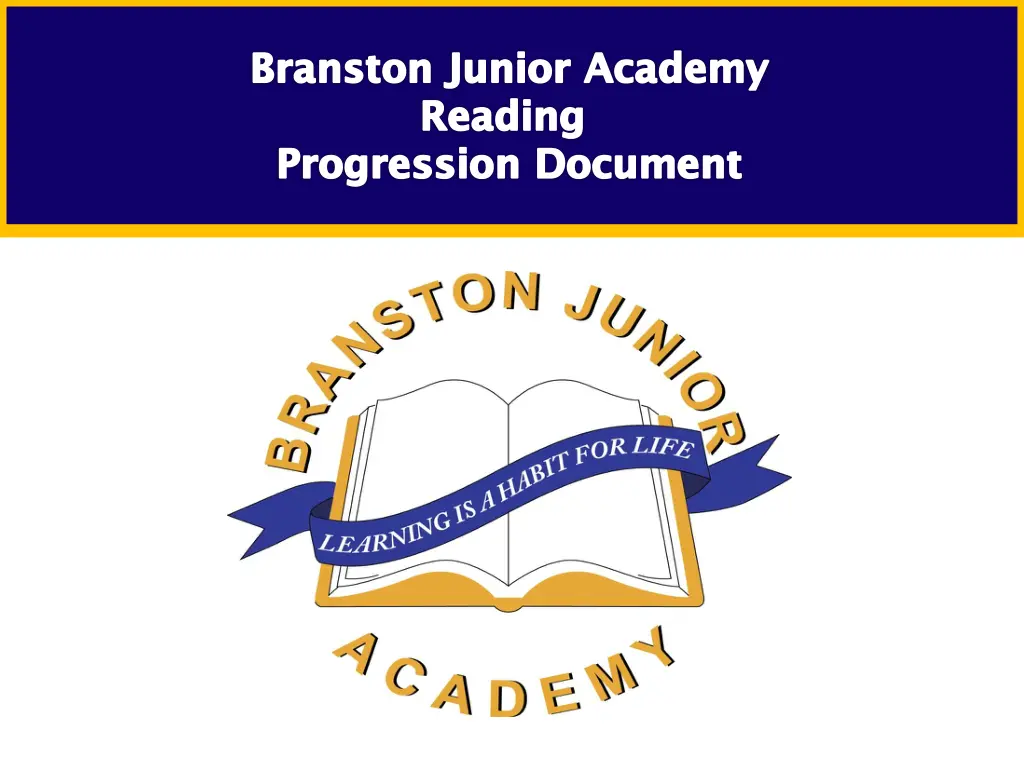
Reading Progression at Branston Junior Academy
Explore the detailed reading progression document at Branston Junior Academy, covering phonics, decoding, spelling, fluency, understanding, and comprehension objectives for different year levels. Enhance your understanding of the structured literacy development program implemented at the school.
Download Presentation

Please find below an Image/Link to download the presentation.
The content on the website is provided AS IS for your information and personal use only. It may not be sold, licensed, or shared on other websites without obtaining consent from the author. If you encounter any issues during the download, it is possible that the publisher has removed the file from their server.
You are allowed to download the files provided on this website for personal or commercial use, subject to the condition that they are used lawfully. All files are the property of their respective owners.
The content on the website is provided AS IS for your information and personal use only. It may not be sold, licensed, or shared on other websites without obtaining consent from the author.
E N D
Presentation Transcript
Branston Junior Academy Reading Progression Document
Year 1 Year 2 Year 3 Year 4 Year 5 Year 6 Phonics, Decoding and Spelling Phonics, Decoding and Spelling Phonics, Decoding and Spelling Phonics, Decoding and Spelling Phonics, Decoding and Spelling Phonics, Decoding and Spelling Fluency, Understanding and correcting inaccuracies Fluency, Understanding and correcting inaccuracies Fluency, Understanding and correcting inaccuracies Fluency, Understanding and correcting inaccuracies Fluency, Understanding and correcting inaccuracies Fluency, Understanding and correcting inaccuracies Comprehension Comprehension Comprehension Comprehension Comprehension Comprehension
Year 1 Phonics, Decoding and Spelling Year 1 objectives: To apply phonic knowledge and skills as the route to decode words. To blend sounds in unfamiliar words using the GPCs that they have been taught. To respond speedily, giving the correct sound to graphemes for all of the 40+ phonemes. To read words containing taught GPCs. To read words containing -s, -es, -ing, -ed and -est endings. To read words with contractions, e.g. I m, I ll and we ll. To read Y1 common exception words, noting unusual correspondences between spelling and sound and where these occur in words BACK BACK
Year 1 Fluency, Understanding and correcting inaccuracies Year 1 objectives: To accurately read texts that are consistent with their developing phonic knowledge, that do not require them to use other strategies to work out words. To reread texts to build up fluency and confidence in word reading. To check that a text makes sense to them as they read and to self- correct. To read words with more than one syllable that contain taught GPCs BACK BACK
Year 1 Comprehension Year 1 objectives: To listen to and discuss a wide range of fiction, non-fiction and poetry at a level beyond that at which they can read independently. To link what they have read or have read to them to their own experiences. To make links between the text they are reading and other texts they have read. To retell familiar stories in increasing detail. To recite simple poems by heart. To join in with discussions about a text, taking turns and listening to what others say. To discuss the significance of titles and events. To ask and answer questions about a text. To recognise simple recurring literary language in stories and poetry. To discuss word meaning and link new meanings to those already known. To begin to make simple inferences. To predict what might happen on the basis of what has been read so far. BACK BACK
Year 2 Phonics, Decoding and Spelling Year 2 objectives: To continue to apply phonic knowledge and skills to decode words until automatic decoding has become embedded and reading is fluent. To read accurately by blending the sounds in words that contain the graphemes taught so far, especially recognising alternative sounds for graphemes. To accurately read most words of two or more syllables. To read most words containing common suffixes. To read most Y1 and Y2 common exception words BACK BACK
Year 2 Fluency, Understanding and Correcting Inaccuracies Year 2 objectives: To read aloud books (closely matched to their improving phonic knowledge), sounding out unfamiliar words accurately, automatically and without undue hesitation. To reread these books to build up fluency and confidence in word reading. To read words accurately and fluently without overt sounding and blending, e.g. at over 90 words per minute, in age- appropriate texts. To show understanding by drawing on what they already know or on background information and vocabulary provided by the teacher. To check that the text makes sense to them as they read and to correct inaccurate reading. BACK BACK
Year 2 Comprehension Year 2 objectives: To participate in discussion about books, poems and other works that are read to them (at a level beyond at which they can read independently) and those that they can read for themselves, explaining their understanding and expressing their views. To become increasingly familiar with and to retell a wide range of stories, fairy stories and traditional tales. To discuss the sequence of events in books and how items of information are related To recognise simple recurring literary language in stories and poetry. To ask and answer questions about a text. To make links between the text they are reading and other texts they have read (in texts that they can read independently). To discuss and clarify the meanings of words, linking new meanings to known vocabulary. To discuss their favourite words and phrases To make inferences on the basis of what is being said and done. To predict what might happen on the basis of what has been read so far in a text To recognise that non- fiction books are often structured in different ways. To continue to build up a repertoire of poems learnt by heart and reciting with appropriate intonation. BACK
Year 3 Phonics, Decoding and Spelling Year 3 objectives: To use their phonic knowledge to decode quickly and accurately (may still need support to read longer unknown words). To apply their growing knowledge of root words and prefixes, including in-, im-, il-, ir-, dis-, mis-, un-, re-, sub-, inter-, super-, anti- and auto- To read most words fluently and attempt to decode any unfamiliar words with increasing speed and skill. To read aloud. To apply their growing knowledge of root words and suffixes/word endings, including -ation, -ly, -ous, -ture, -sure, -sion, -tion, and -cian, To begin to read Y3/Y4 exception words. BACK BACK
Year 3 Fluency, Understanding and Correcting Inaccuracies Year 3 objectives: Read aloud books, sounding out unfamiliar words accurately, automatically and without hesitation. Recognise punctuation, pausing at key moments. To check that the text makes sense to them as they read and to correct inaccurate reading. To check books make sense to them and discuss and understand the meaning of words in context BACK BACK
Year 3 Comprehension Year 3 objectives: To understand how language, structure and presentation contribute to meaning. To recognise, listen to and discuss a wide range of fiction, poetry, plays, non-fiction and reference books or textbooks. To use appropriate terminology when discussing texts (plot, character, setting). To check that the text makes sense to them, discussing their understanding and explaining the meaning of words in context. To draw inferences from characters feelings, thoughts and motives that justifies their actions, supporting their views with evidence from the text. To discuss authors choice of words and phrases for effect. To ask and answer questions appropriately, including some simple inference questions based on characters feelings, thoughts and motives. To predict what might happen from details stated and implied. To justify predictions using evidence from the text. To retrieve and record information from non- fiction texts. BACK BACK
Year 4 Phonics, Decoding and Spelling Year 4 objectives: To read most words fluently and attempt to decode any unfamiliar words with increasing speed and skill. To apply their knowledge of root words, prefixes and suffixes/word endings to read aloud fluently. To read all Y3/Y4 exception words BACK BACK
Year 4 Fluency, Understanding and Correcting Inaccuracies Year 4 objectives: Read clearly and apply punctuation accurately. Use expression and intonation with a growing awareness of the audience and purpose. Word reading should support the development of vocabulary. To read most words fluently and decode unfamiliar words with increasing speed and skill. To check that the text makes sense to them as they read and to correct inaccurate reading. BACK BACK
Year 4 Comprehension Year 4 objectives: To discuss and compare texts from a wide variety of genres and writers. To read for a range of purposes. To identify themes and conventions in a wide range of books. To refer to authorial style, overall themes (e.g. triumph of good over evil) and features (e.g. greeting in letters, a diary written in the first person or the use of presentational devices such as numbering and headings). To identify how language, structure and presentation contribute to meaning. To identify main ideas drawn from more than one paragraph and summarise these. Discuss vocabulary used to capture readers interest and imagination. To draw inferences from characters feelings, thoughts and motives that justifies their actions, supporting their views with evidence from the text. To justify predictions from details stated and implied. To use all of the organisational devices available within a non-fiction text to retrieve, record and discuss information. To use dictionaries to check the meaning of words that they have read. To prepare poems and playscripts to perform and read aloud using the appropriate intonation, tone, volume and action to aid clarity. BACK
Year 5 Phonics, Decoding and Spelling Year 5 objectives: To read most words fluently and attempt to decode any unfamiliar words with increasing speed and skill, recognising their meaning through contextual cues. To apply their growing knowledge of root words, prefixes and suffixes/ word endings, including -sion, -tion, -cial, -tial, -ant/-ance/-ancy, -ent/- ence/-ency, -able/-ably and -ible/ibly, To read aloud fluently. To read most Y5/ Y6 exception words. BACK BACK
Year 5 Fluency, Understanding and Correcting Inaccuracies Year 5 objectives: Read fluently, using punctuation, expression and intonation of a growing vocabulary, showing an awareness of the intended audience and purpose. To check that the text makes sense to them as they read and to correct inaccurate reading. To check the book makes sense to them and discuss the meaning of words in context. BACK BACK
Year 5 Comprehension Year 5 objectives: To read a wide range of genres, identifying the characteristics of text types (such as the use of the first person in writing diaries and autobiographies) and differences between text types. To identify and discuss themes and conventions in and across a wide range of writing. To explain and discuss their understanding of what they have read, including through formal presentations and debates, maintaining a focus on the topic and using notes where necessary. To participate in discussions about books that are read to them and those they can read for themselves, building on their own and others ideas and challenging views courteously. To identify main ideas drawn from more than one paragraph and to summarise these. To recommend texts to peers based on personal choice. To discuss vocabulary used by the author to create effect including figurative language. To evaluate the use of authors language and explain how it has created an impact on the reader. To draw inferences from characters feelings, thoughts and motives. To make predictions based on details stated and implied, justifying them in detail with evidence from the text. To use knowledge of texts and organisation devices to retrieve, record and discuss information from fiction and non-fiction texts. Distinguish between statements of fact and opinion. Read for a range of purposes. To continually show awareness when preparing poems and playscripts to read and perform using intonation, tone and volume to make the meaning clear. Learn a range of poems by heart. BACK BACK
Year 6 Phonics, Decoding and Spelling Year 6 objectives: To read fluently with full knowledge of all Y5/ Y6 exception words, root words, prefixes, suffixes/word endings To decode any unfamiliar words with increasing speed and skill, recognising their meaning through contextual cues. BACK BACK
Year 6 Fluency, Understanding and Correcting Inaccuracies Year 6 objectives: Use punctuation, expression and intonation of a wider vocabulary to create moods, showing an appreciation of the audience and purpose. To check that the text makes sense to them as they read and to correct inaccurate reading. To check that a book makes sense and the discuss and understand the meaning of words in context. BACK BACK
BACK Year 6 Comprehension BACK Year 6 objectives: To read for pleasure, discussing, comparing and evaluating in depth across a wide range of genres, including myths, legends, traditional stories, modern fiction, fiction from our literary heritage and books from other cultures and traditions. To recognise more complex themes in what they read (such as loss or heroism). To explain and discuss their understanding of what they have read, including through formal presentations and debates, maintaining a focus on the topic and using notes where necessary. To listen to guidance and feedback on the quality of their explanations and contributions to discussions and to make improvements when participating in discussions. To draw out key information and to summarise the main ideas in a text. To make predictions based on details stated and implied, justifying them in detail with evidence from the text. To ask questions to improve understanding. To check the book makes sense discussing the meaning of words in context. To distinguish independently between statements of fact and opinion, providing reasoned justifications for their views. To compare characters, settings and themes within a text and across more than one text To analyse and evaluate the use of language, including figurative language and how it is used for effect, using technical terminology such as metaphor, simile, analogy, imagery, style and effect. To consider different accounts of the same event and to discuss viewpoints (both of authors and of fictional characters). To discuss how characters change and develop through texts by drawing inferences based on indirect clues. To retrieve, record and present information from non-fiction texts. To confidently perform texts(including poems learnt by heart) using a wide range of devices to engage the audience and for effect To use non-fiction materials for purposeful information retrieval (e.g. in reading history, geography and science textbooks) and in contexts where pupils are genuinely motivated to find out information (e.g.
Guided reading questions based on objectives year 1 Guided reading questions based on objectives year 2 Guided reading questions based on objectives year 3/4 Guided reading questions based on objectives year 5/6 BACK BACK

